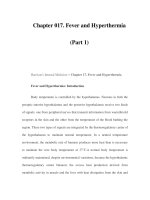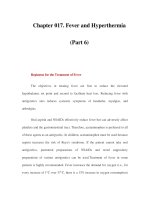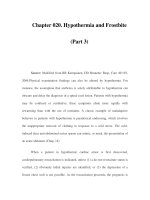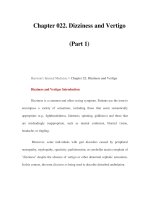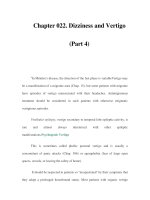Chapter 059. Bleeding and Thrombosis (Part 6) doc
Bạn đang xem bản rút gọn của tài liệu. Xem và tải ngay bản đầy đủ của tài liệu tại đây (56.6 KB, 5 trang )
Chapter 059. Bleeding and Thrombosis
(Part 6)
Underlying Systemic Diseases that Cause or Exacerbate a Bleeding
Tendency
Acquired bleeding disorders are commonly secondary to, or associated
with, systemic disease. The clinical evaluation of a patient with a bleeding
tendency must therefore include a thorough assessment for evidence of underlying
disease. Bruising or mucosal bleeding may be the presenting complaint in liver
disease, severe renal impairment, hypothyroidism, paraproteinemias or
amyloidosis, and conditions causing bone marrow failure. All coagulation factors
are synthesized in the liver and hepatic failure results in combined factor
deficiencies. This is often compounded by thrombocytopenia from splenomegaly
due to portal hypertension. Coagulation factors II, VII, IX, X and proteins C, S,
and Z are dependent on vitamin K for posttranslational modification. Although
Vitamin K is required in both procoagulant and anticoagulant processes, the
phenotype of vitamin K deficiency or the warfarin effect on coagulation is
bleeding.
The normal blood platelet count is 150,000–450,000/βL.
Thrombocytopenia results from decreased production, increased destruction,
and/or sequestration. Although the bleeding risk varies somewhat by the reason for
the thrombocytopenia, bleeding rarely occurs in isolated thrombocytopenia at
counts <50,000/µL and usually not until <10,000–20,000/µL. Coexisting
coagulopathies, as seen in liver failure or disseminated coagulation; infection;
platelet-inhibitory drugs; and underlying medical conditions can all increase the
risk of bleeding in the thrombocytopenic patient. Most procedures can be
performed in patients with a platelet count of 50,000/µL. The level needed for
major surgery will depend on the type of surgery and the patients' underlying
medical state, although a count of approximately 80,000/µL is likely sufficient.
History of Thrombosis
The risk of thrombosis, like that of bleeding, is influenced by both genetic
and environmental influences. The major risk factor for arterial thrombosis is
atherosclerosis, while those for venous thrombosis are immobility, surgery,
underlying medical conditions such as malignancy, medications such as hormonal
therapy, obesity, and genetic predispositions. Factors that increase risks for venous
and both venous and arterial thromboses are shown in Table 59-3.
Table 59-3 Risk Factors for Thrombosis
Venous Venous and Arterial
Inherited Inherited
Factor V Leiden Homocystinuria
Prothrombin G20210A Dysfibrinogenemia
Antithrombin deficiency
Protein C deficiency Mixed (Inherited and acquired)
Protein S deficiency Hyperhomocysteinemia
Elevated FVIII
Acquired
Acquired Malignancy
Age Antiphospholipid antibody syndrome
Previous thrombosis Hormonal therapy
Immobilization Polycythemia vera
Major surgery Essential thrombocythemia
Pregnancy & puerperium Paroxysmal nocturnal hemoglobinuria
Hospitalization Thrombotic thrombocytopenic purpura
Obesity Heparin-induced thrombocytopenia
Infection
Disseminated intravascular
coagulation
APC resistance,
nongenetic
Unknown
a
Elevated factor II, IX, XI
Elevated TAFI levels
Low levels of TFPI
a
Unknown whether risk is inherited or acquired.
Note: APC, activated protein C; TAFI, thrombin-activatable fibrinolysis
inhibitor; TFPI, tissue factor pathway inhibitor.

